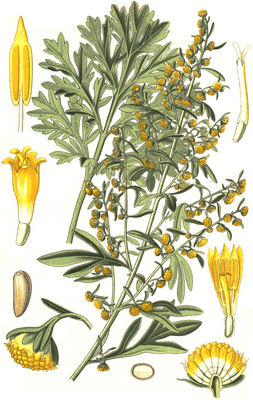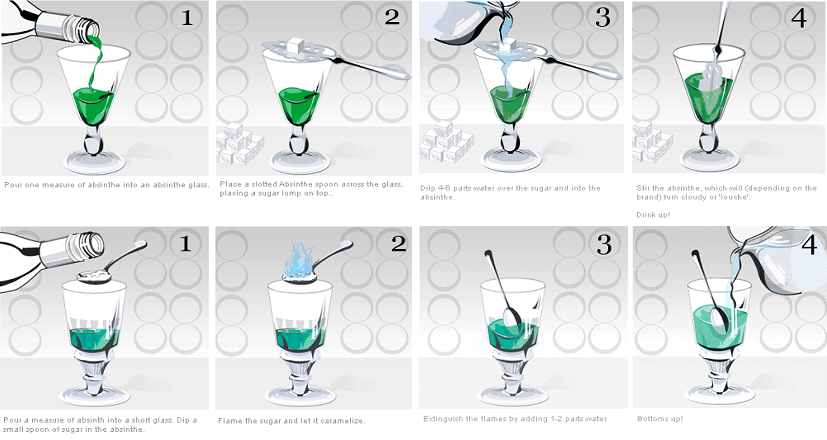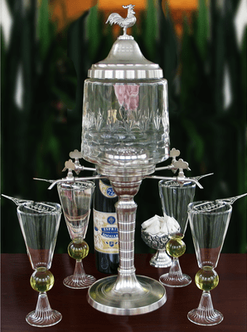Absinthe Information

What Is An Absinthe Fountain
*Although new metal absinthe fountains are no longer an option due to quality issues (More Info), older metal absinthe fountains are still available. USE CAUTION IF PURCHASING A NEW METAL FOUNTAIN.
An absinthe fountain is a dispenser for water used in serving absinthe to perform the “Louche” ritual. The absinthe fountain is an essential accessory if you are looking to mix the perfect absinthe while re-creating the ambiance of the “Belle Epoque” or beautiful period. Absinthe fountains come in many styles and sizes and most are beautifully ornate in design (Modern Absinthe Fountain – Left).
They consist of a container which is usually a glass bowl for holding water and between 2 and 6 faucets around the bowl. The faucets are used to slowly drip water into your glass containing a dose of absinthe. When water is added to absinthe, the alcohol content falls allowing the botanical oils to precipitate out of the mixture. As the precipitate increases, the classic louche will form giving the drink a milky, white, opalescent appearance.
The absinthe fountain became an important part of the absinthe ritual. Absinthe connoisseurs know that to achieve the best quality louche, a slow stream of ice-cold water is far better than simply adding water to your glass. Even pouring slowly from a decanter can’t match the quality of louche produced with an absinthe fountain.
Oftentimes, the fountain would became the centerpieces of absinthe cafes and lounges. However, most absinthe experts consider the absinthe fountain more than just a water dispense but more an ornamental piece of art. Absinthe fountains are again sparking interest of the belle epoque and its beauty and decadence.
Many specialized stores are selling absinthe fountains together with the accessories used in the preparation of absinthe.  Both old-time absinthe experts and young connoisseurs are now again enjoying the awesome louche an absinthe fountain will provide. At right is an etched glass absinthe fountain set.
Both old-time absinthe experts and young connoisseurs are now again enjoying the awesome louche an absinthe fountain will provide. At right is an etched glass absinthe fountain set.
If you can afford a nice absinthe fountain, consider yourself fortunate as they perform the absinthe ritual just like in Paris bistros and cafes at the turn of the 18th century.
 A fine example of an antique absinthe fountain is in New Orleans at a bar named the “Olde Absinthe House” (Left). They have on display a gorgeous marble fountain adorned with a brass statue of Napoleon dating back to 1754. The Old Absinthe House is located in the heart of the French Quarter at the corner of Bourbon Street and Bienville.
A fine example of an antique absinthe fountain is in New Orleans at a bar named the “Olde Absinthe House” (Left). They have on display a gorgeous marble fountain adorned with a brass statue of Napoleon dating back to 1754. The Old Absinthe House is located in the heart of the French Quarter at the corner of Bourbon Street and Bienville.
Built in 1806 by Pedro Front and Francisco Juncadelia of Barcelona, it was used to house their importing firm where they sold food, tobacco and Spanish liquor. It endures the name of Jean Lafitte because of the rumored meeting of the Pirate Jean Lafitte and Andrew Jackson as they planned the victory of the battle of New Orleans on the second floor.
Workers at the Old Absinthe House have many stories about seeing the ghost of Jean Lafitte after dark. In 1815, the ground floor was turned into the “Aleix’s Coffee House” saloon later rechristened “The Absinthe Room” when bartender Cayetano Ferrer created the famous Absinthe House Frappe in 1874. To this day, The Old Absinthe House has the still working, decorative marble fountains used to prepare absinthe.
The original Old Absinthe House was almost destroyed at the start of Prohibition as a warning that Absinthe was to be abolished from the United States and would not be tolerated. Luckily, the bar was moved to a clandestine location in order to save it.
Absinthe Effect | Fact Or Myth
The source of the “Absinthe Effect” has been a point of contention since the introduction of this magic elixir in the 1700’s. To this day, there is still debate whether or not the absinthe effect truly exists. I can tell you that I have experienced the absinthe effect and continue to do so on a regular basis. Let me explain further.
It is known that more than one herb used in the production of absinthe exhibits psychotropic properties. Psychotropic substances effect the CNS (central nervous system) in a way that alters brain function. Such effects can manifest as changes in mood, perception, consciousness and behavior.
 There is more than one substance in absinthe that acts on the CNS. We will concentrate on the substance known to have the most prominent effect. In addition to alcohol, absinthe’s major psychotropic substance is Thujone. Thujone is the chemical compound derived from the herb Artemisia Absinthium or Wormwood (aka Grand Wormwood) pictured left. There is much complexity involved in classifying the different Species and Genus of this plant class (such as the amount of thujone contained in the different species) that go beyond the scope of this article.
There is more than one substance in absinthe that acts on the CNS. We will concentrate on the substance known to have the most prominent effect. In addition to alcohol, absinthe’s major psychotropic substance is Thujone. Thujone is the chemical compound derived from the herb Artemisia Absinthium or Wormwood (aka Grand Wormwood) pictured left. There is much complexity involved in classifying the different Species and Genus of this plant class (such as the amount of thujone contained in the different species) that go beyond the scope of this article.
For our purposes, we will refer to it simply as Wormwood or Thujone. Thujone was once thought to act on the area of the brain that responds to THC (marijuana) as their chemical structures are somewhat similar. This has been proven false. Thujone is now known to act on a receptor in the brain known as the GABA (gamma-aminobutyric acid) receptor. When activated by GABA, the GABA receptor instructs your brain to slow down and relax. Thujone acts as a GABA receptor antagonost (inhibitor).
Thujone blocks the GABA receptor preventing GABA from activating the receptor. As the receptor cannot be activated, it will not instruct your brain to relax and slow down keeping your brain in a state of stimulation and alertness. It may be helpful to understand that some drugs have the opposite action of Thujone.
These drugs are GABA receptor agonists (as opposed to antagonists). They increase the GABA receptors message to the brain to relax. These medications are used for various purpose such as relief of anxiety. Drugs in this class include Benzodiazepines like Valium or Xanax and Barbiturates like Phenobarbital. So what Thujone does is basically the opposite of taking Valium. It tells the brain to wake up!
How To Mix Absinthe?
One of the most interesting aspects of absinthe it is mixed and prepared or – The Absinthe Ritual. The most well known ways to mix absinthe are traditional French Absinthe Ritual and the Modern or Bohemian Absinthe Ritual.
The traditional ritual of drinking absinthe is to place a sugar cube on your absinthe spoon while the spoon is placed atop your absinthe glass containing a dose of absinthe. Cold water is slowly dripped over the sugar cube allowing the sugar to melt and drip through the holes of the slotted absinthe spoon and mix with the absinthe. As water is added to absinthe, the alcohol concentration will drop which allows the anise and other herbal oils to separate out. The process will cause the absinthe to take a milky, opalescent appearance. This is called the louche and will only happen if the absinthe was distilled properly with the correct ingredients. Poor quality absinthe will not produce the louche effect.
The modern ritual for drinking absinthe became a popular method using fire to make absinthe preparation look more exciting. The fire or Bohemian Absinthe ritual is done the same way as the traditional method with the sugar cube being soaked in absinthe before put on the spoon. The cube is then lit on fire and allowed to melt the sugar into the glass. While the sugar is flaming, it is dropped into the glass to ignite the absinthe. Water is then added to extinguish the flame. Although this method may look interesting, it is dangerous and will ruin the taste of your absinthe. Serious absintheurs will never light their absinthe on fire as it does nothing but make your absinthe taste terrible and possibly cause 3rd degree burns when the glass tips over.

COPYRIGHT Absinthe Accessories 2007-2022 Contact Us: BestAbsintheReviews@gmail.com@gmail.com
